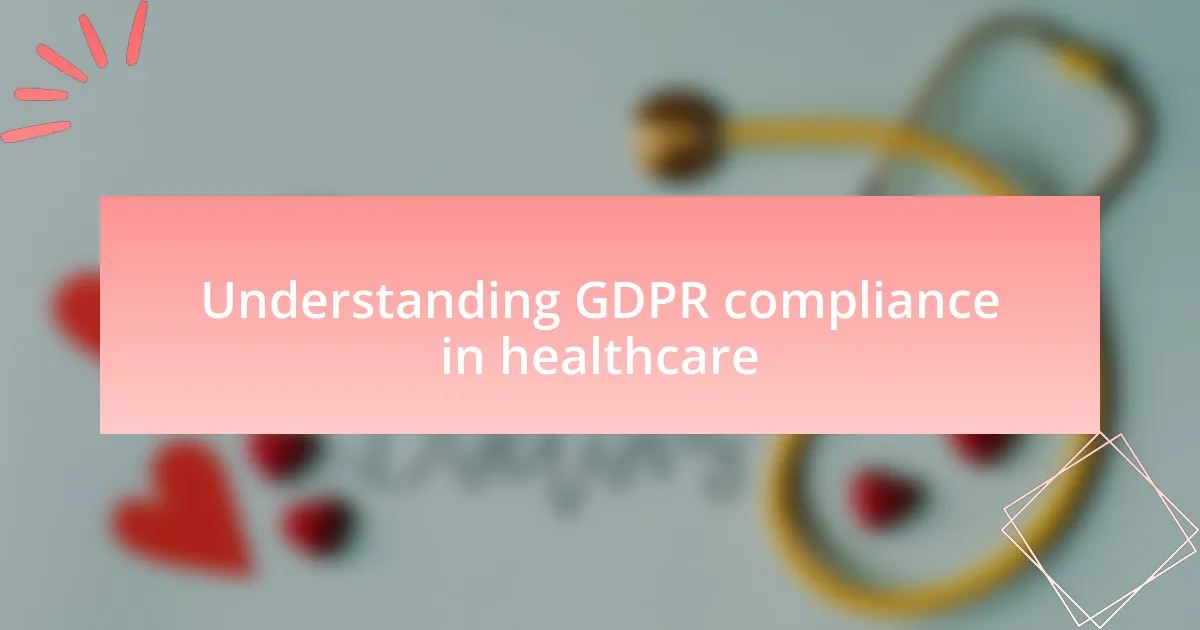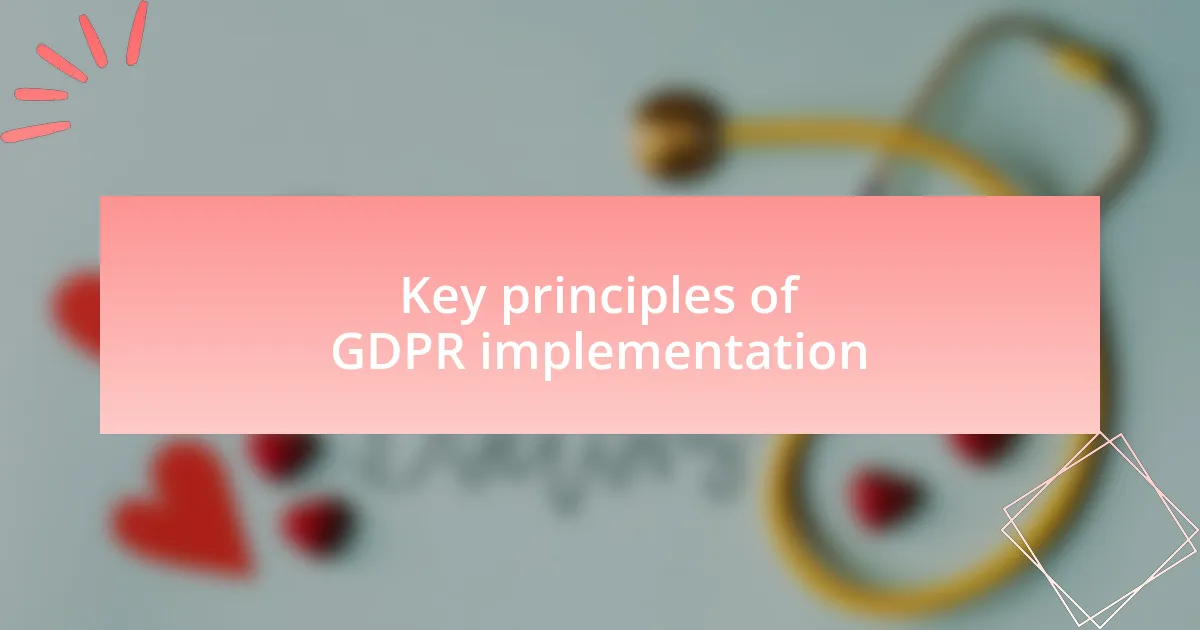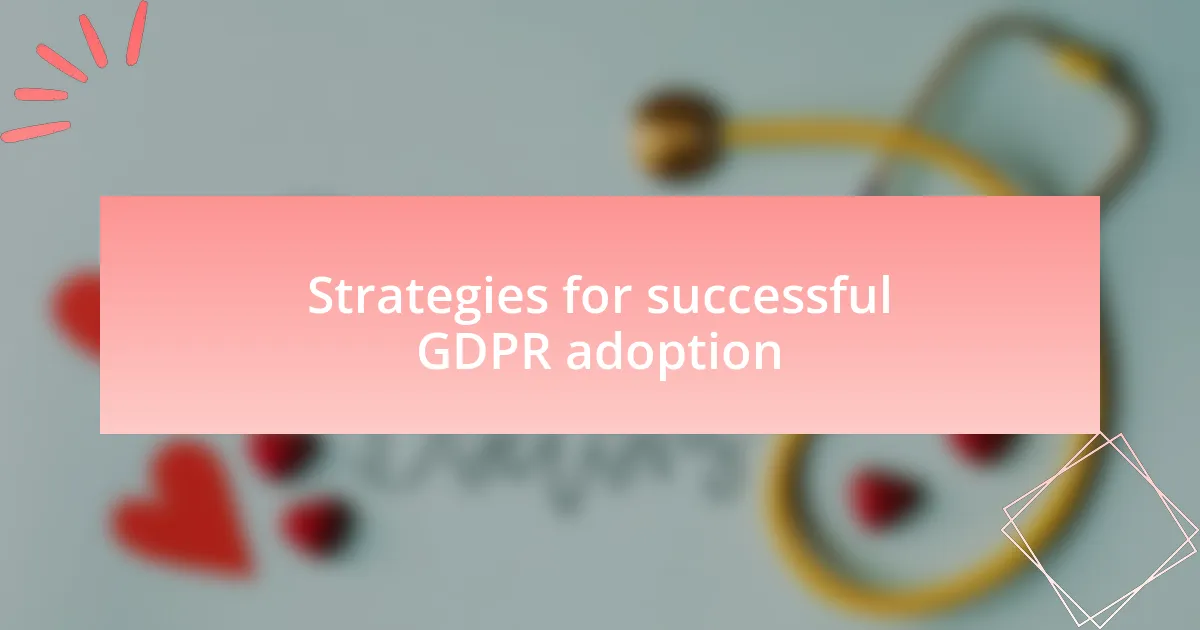Key takeaways:
- Trust and patient consent are fundamental in GDPR compliance, requiring clear communication of data handling practices.
- Transparency and accountability are crucial principles, emphasizing the importance of clear roles and thorough training for data management.
- Overcoming staff anxiety and fostering a culture of awareness through education and open communication enhances compliance efforts.
- Navigating regulatory ambiguity necessitates legal consultation and encourages ongoing dialogues about compliance within the organization.

Understanding GDPR compliance in healthcare
Understanding GDPR compliance in healthcare requires a deep appreciation of how personal data must be handled. As I navigated this complex landscape, I found myself reflecting on the concept of trust. Patients need to feel secure that their sensitive information won’t be mishandled. Isn’t that a fundamental expectation we all have when seeking medical care?
During my implementation journey, I faced numerous challenges, especially concerning data minimization—the idea that only necessary data should be collected. I often wondered, how can we balance the need for comprehensive healthcare with the need for privacy? This constant tension pushed me to be more thoughtful about our data policies and reinforced my commitment to creating a safe patient environment.
Moreover, the role of consent in GDPR can’t be overstated. I remember discussions with my team about gathering explicit consent from patients. While it’s an essential step, it made me realize how important it is to communicate clearly with patients. How can we ensure they understand what they’re consenting to? This question became a cornerstone of our approach, transforming compliance into a shared journey rather than a checkbox exercise.

Key principles of GDPR implementation
One of the key principles of GDPR implementation is transparency. I recall a moment during our project when we revamped our privacy notice. It was a challenge to ensure that it was not only compliant but also understandable to our patients. We often asked ourselves, how can we present this information in a way that patients truly grasp? Our solution was to simplify the language and provide relatable examples, making it evident that openness fosters trust.
Accountability is another pivotal element. Early in my journey, I recognized the importance of having clear roles and responsibilities for data management. It hit me during a team meeting that if something went wrong, we needed to be prepared. Who would take responsibility? This realization led us to establish robust procedures and regular training sessions, ensuring that everyone understood their part in safeguarding patient data.
Lastly, I saw firsthand how the principle of data protection by design and default impacts every facet of our operations. While designing a new patient management system, we prioritized incorporating privacy measures from the start. I often asked my colleagues, what if data protection isn’t just an afterthought but an integral part of our innovation? This mindset shift was incredibly empowering, transforming compliance into a proactive strategy that enhances our healthcare delivery.

Challenges faced during GDPR implementation
When implementing GDPR, one of the most significant hurdles I faced was ensuring staff buy-in. I remember conducting a workshop where it quickly became clear that many team members felt overwhelmed by new regulations. How could I turn that anxiety into enthusiasm? By framing GDPR as an opportunity to elevate our patient care, I was able to encourage my colleagues to view compliance not as a burden but as a way to reinforce our commitment to patient trust.
Another challenge was managing data across various platforms and systems. In one particular instance, our electronic health records system was not fully compliant, which sent us scrambling to find ways to integrate necessary changes. It was frustrating to realize how interconnected our systems were and how a simple oversight could pose complications. This made me appreciate the essential role of thorough audits in identifying areas that needed immediate attention.
Perhaps the most daunting aspect was navigating the ambiguity in GDPR’s language. I vividly recall a moment when I was buried in legal documents, trying to discern the implications of “legitimate interests.” Questions raced through my mind: Were we fully compliant, or were we treading a thin line? Ultimately, I learned the importance of consulting with legal experts early on to clarify uncertainties and avoid potential pitfalls. This pushed me to advocate for ongoing dialogues about compliance within our organization.

Strategies for successful GDPR adoption
One effective strategy for successful GDPR adoption is fostering a culture of awareness and education within the team. I remember scheduling regular training sessions where employees could ask questions and share their concerns. This openness not only demystified GDPR but also cultivated a sense of ownership among staff. Wouldn’t you agree that when people understand the “why” behind regulations, they are more likely to embrace them?
Another key approach is prioritizing clear communication about data handling practices. I recall creating visual guides that mapped out data flows and usage across our systems. These visuals were a game-changer; they helped people visualize how we collected, stored, and processed information, making the abstract concepts more tangible. It’s incredible how a straightforward infographic can transform confusion into clarity!
Finally, incorporating feedback loops can significantly enhance compliance efforts. After rolling out our GDPR strategies, I initiated monthly check-ins where team members could share their experiences and suggest improvements. I found that this not only boosted morale but also revealed practical insights that we might have otherwise overlooked. Have you ever noticed how the best ideas often come from those directly engaged with the processes?

My personal experience with GDPR
Navigating the waters of GDPR implementation was like stepping into a maze for me, filled with twists and turns. I distinctly remember those early days when I felt overwhelmed by the sheer volume of compliance requirements. It was during a late-night brainstorming session over a cup of coffee that I realized how critical it was to approach this not just as a legal obligation but as a fundamental shift in how we treat personal data. Have you ever felt the weight of responsibility that comes with safeguarding someone’s information?
One pivotal moment for me came when we faced a real dilemma regarding a data breach incident. It was nerve-wracking, to say the least. I had to quickly assess our protocols and communicate transparently with affected stakeholders. The pressure was immense, yet I learned the value of trust and honesty in those tough situations. It made me appreciate that even when things go wrong, how we respond can define our integrity. Isn’t it fascinating how crises can reveal our true commitment to principles?
Reflecting on the journey, I can’t help but acknowledge the emotional rollercoaster that GDPR implementation brought. There were triumphs, like achieving full compliance ahead of the deadline, and setbacks that left me questioning our processes. What really kept me going was the commitment I saw within my team as we rallied together to tackle each challenge. It’s moments like these that remind me how collaborative effort can turn daunting initiatives into collective victories. Don’t you think that shared struggles not only strengthen teams but also build resilience?